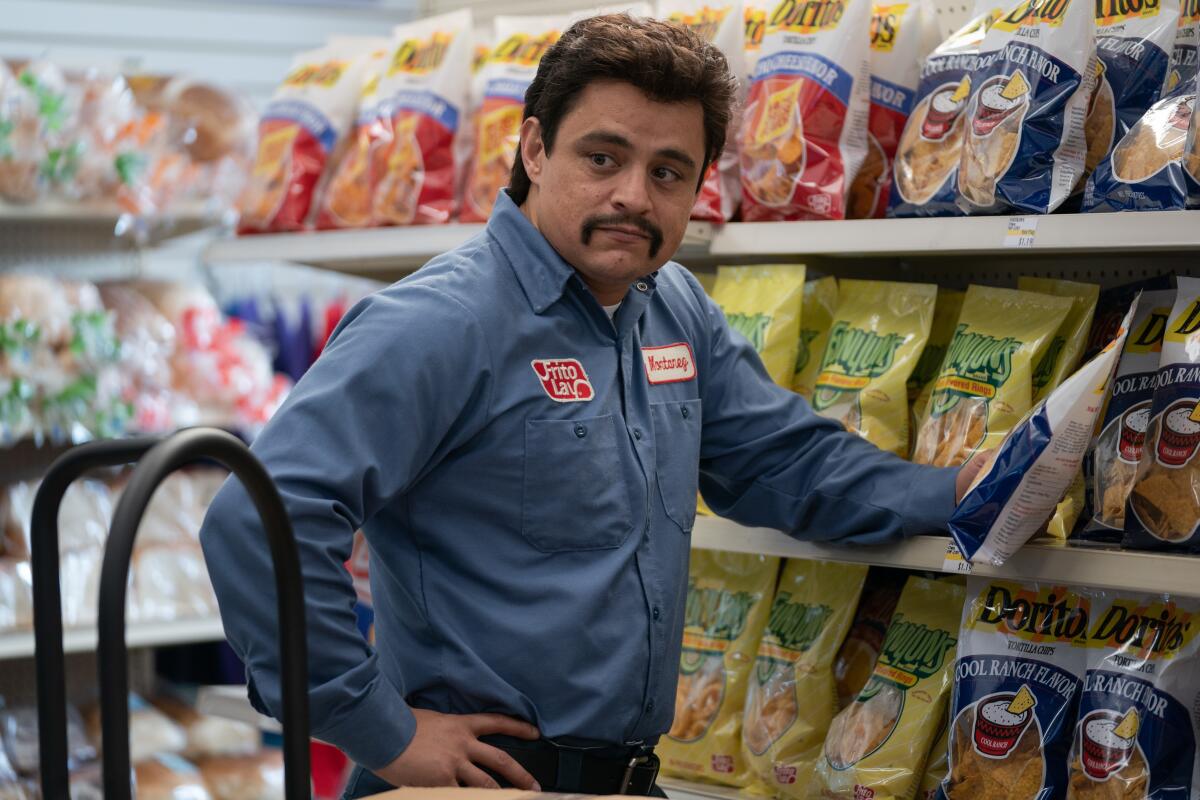Opinion: What the film ‘Flamin’ Hot’ can teach Hollywood about the perils of neglecting Latinos

- Share via
When the new film “Flamin’ Hot” arrives on streaming platforms on Friday, audiences should prepare themselves for something they don’t often see. This movie puts a Latino — Richard Montañez, played by Jesse Garcia — front and center. While this may not seem like a radical act, only 4% of the 1,600 most popular movies from 2007 to 2022 featured a Latino in the lead.
“Flamin’ Hot” does more than just defy the odds on screen. Behind the scenes, this film about snack foods shatters other conventions. Among the 1,600 top-grossing films from the last 16 years, only one out of every 320 had a Latina director. Only one was directed by a Mexican American woman. In other words, you’re more likely to know a person hit by lightning or to be born on Feb. 29 than to see a top-grossing film with someone like Eva Longoria — yes, the actor-producer-director Eva Longoria — at the helm.
It isn’t just the director either. A mere 3% percent of all casting directors in top-grossing films are Latinos. From the top of the call sheet to the last credit to roll, the composition of the cast and crew on “Flamin’ Hot” is an anomaly.
The Latino community has a rich history and strong cultural impact in this country, but you wouldn’t know it by watching movies. “Flamin’ Hot” takes direct aim at the lack of Latinos in film and the persistent stereotyping they face. It puts businessman Montañez at the center of the story and surrounds him with Latino family and friends. Given that our research shows that 50% of Latino main characters are isolated on screen, the film provides an important lens on Latino family and community life. The movie also showcases key aspects of Latino culture — food, faith, clothing, relationships — that are often absent from popular movies.
Hollywood is often quick to tell stories of the Latino as an outsider, someone who wasn’t born in this country and doesn’t have a say in shaping American values. Although the majority of the U.S. Hispanic/Latino population is born in the U.S., only about one-third of the Hispanic/Latino characters we examined in 2019 were Latinos born in the U.S. “Flamin’ Hot” has no time for such myths: The Latinos at the core of this story are fully American and fully Mexican, and as the characters demonstrate, this means they have an advantage that often goes overlooked.
Just as “Flamin’ Hot” Cheetos revealed that the Latino market is a powerful force to drive consumer behavior — even outside the community — so too can “Flamin’ Hot” serve as a call to action for Hollywood. First, we need more Latino stories brought to the screen. These stories exist and are waiting to be told. Similarly, the talent is there; the people who brought “Flamin’ Hot” to the screen represent a much larger community of talented Latinos who are ready to be hired for stories that should feature Latinos.
The rest of the industry has a role to play as well. Talent agencies must recruit and sign more talent and push for their clients to appear in more stories. Casting directors should commit to casting processes that ensure Latino actors are auditioned and cast in greater numbers. Film festivals, nonprofits and philanthropists can designate funding and create initiatives to support and accelerate the work of Latino filmmakers.
Corporations — even those outside of the entertainment industry — can ensure that their marketing and promotional efforts support Latinos. For example, McDonald’s created the Spotlight Dorado program to provide funding for Latino filmmakers and mentorship opportunities. As “Flamin’ Hot” so clearly demonstrates, corporations ignore Latinos to their own detriment.
The Latino market for snacks was all but ignored until decision-makers were reminded about the power of this consumer group. The irony that a movie should make this point is not lost on us. Despite the reliability of Latino audiences to show up at the multiplex, Latinos are rarely (if ever) the focus of or the creative force behind top films. This must change.
The entertainment industry should learn from this movie and continue to serve the Latino community with stories that authentically represent this audience, told by storytellers who identify as Latino. As this new film shows us, there’s no limit to the number of products that can be made “Flamin’ Hot” — and there should be no limit on the number of Latino stories, either.
Ariana Case is the program manager and Katherine Pieper is the program director of the USC Annenberg Inclusion Initiative, founded by Stacy L. Smith, a professor at the Annenberg School for Communication and the USC School of Dramatic Arts.
More to Read
A cure for the common opinion
Get thought-provoking perspectives with our weekly newsletter.
You may occasionally receive promotional content from the Los Angeles Times.










